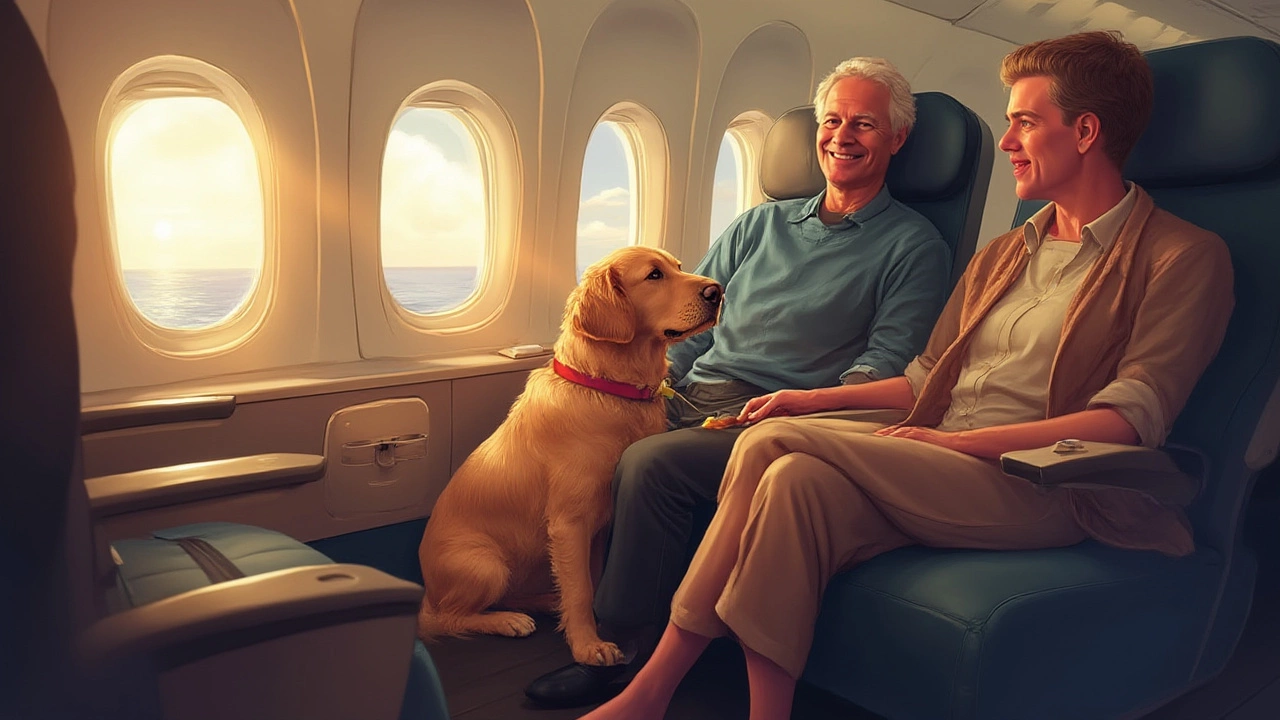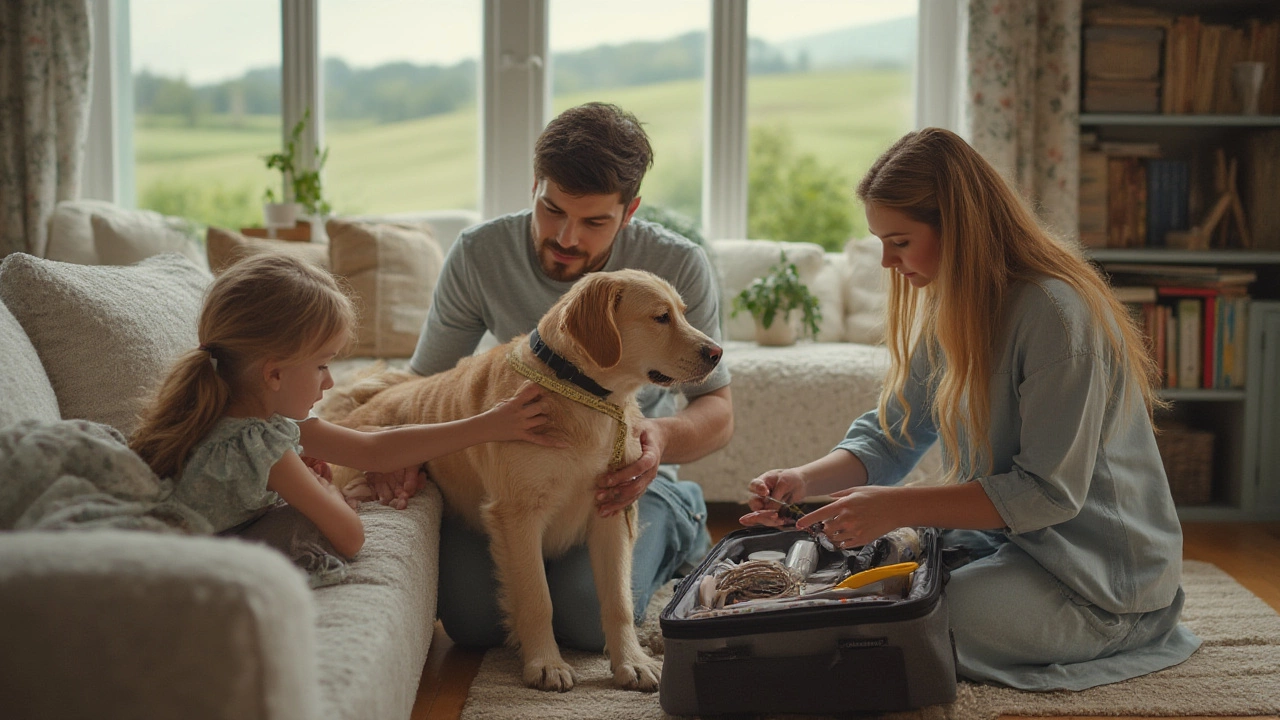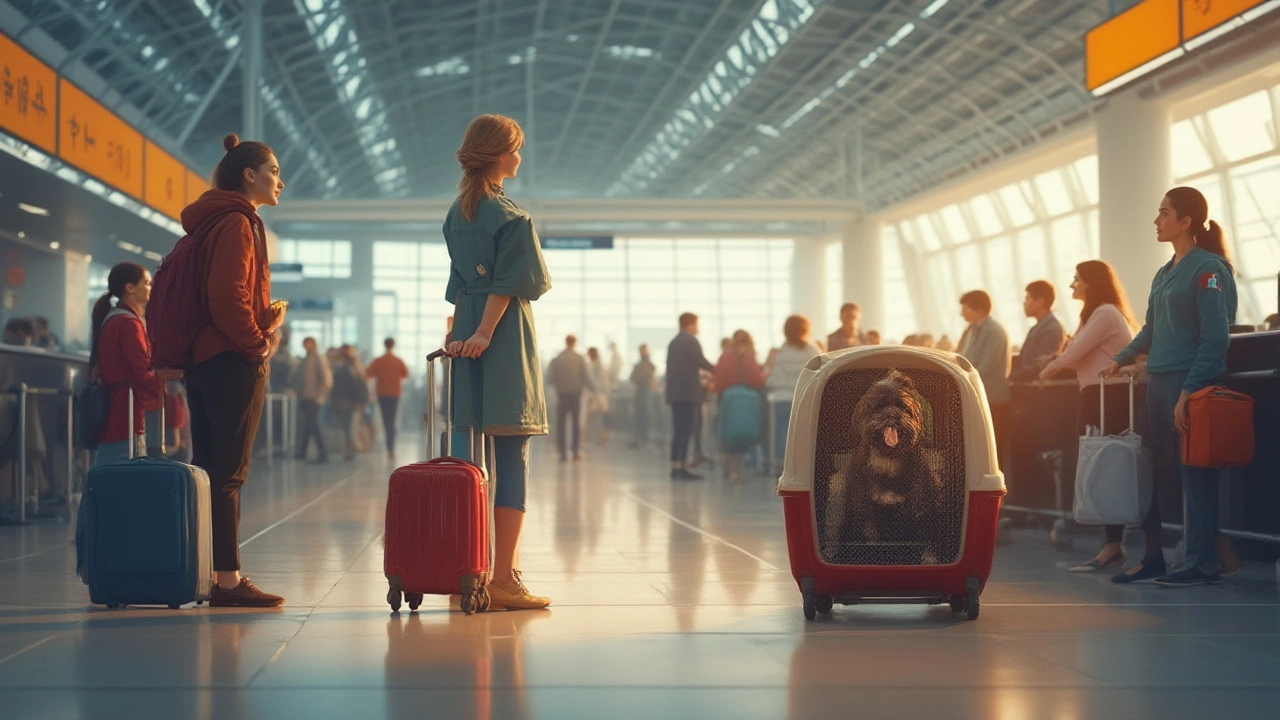I’ll just say it: trying to fit a big, wiggly 50-pound dog into an airplane cabin beside your knees isn’t as simple as it should be. People see their Chihuahua in a backpack and assume the same rules apply to every pup—but traveling with a dog Bruno’s size is a whole different beast. One minute you’re dreaming of him snoring happily at your feet, the next, you’re deep-diving into airline fine print and realizing, yikes, maybe your dog needs his own ticket just for his tail. Is it even possible to fly in the cabin with a large dog? If so, how? If not, why do you keep hearing stories on Reddit about folks sneaking their full-grown Huskies onto international flights? The only thing everyone agrees on is how confusing pet travel rules have gotten since airlines changed their policies in the last couple of years.
What Airlines Really Allow: The Cabin Size Dilemma
Here’s the hard truth: almost every major airline has a strict weight limit for dogs traveling in the cabin. As of July 2025, most U.S. and European airlines cap that limit between 17 and 25 pounds (about 8 to 11 kg) when the pet is in its carrier and squeezed under the seat. A 50-pound dog, like my own goofy Bruno, is about double that—unless you’ve taught him to fold up like origami, he’s not passing as a "carry-on." According to 2024 data from the International Air Transport Association (IATA), less than 2% of commercial flights worldwide allow dogs over 30 lbs in the cabin.
Why are airlines this strict? The answer’s surprisingly practical. Cabin pet rules exist for passenger safety (nobody wants a panicked German Shepherd in an emergency), plus space—those footwells were designed for shoes, not dog butts. The under-seat space on economy class averages just 18 x 12 x 10 inches (46x31x25 cm). Even the tiniest crate for a 50-pound dog exceeds this.
So, who gets exceptions, and why do you see large dogs lounging in business cabins on TikTok? Emotional Support Animal (ESA) rules used to be a loophole, especially with U.S. carriers. But as of 2021, most major airlines updated rules excluding ESAs, only allowing trained service animals—a much stricter category. For example, Delta, American Airlines, and Aer Lingus all state that only dogs trained for disability-related assistance (like guide dogs) can fly out of the crate, regardless of size. And yes, service dogs get to snuggle up with their handler, no carrier needed. But that documentation is checked, thoroughly.
If your 50-pound dog is a pet, not a registered service animal, here’s what most airline policies look like in a nutshell:
| Airline | Max Weight (in-cabin pet) | Carrier Size Limit |
|---|---|---|
| Delta | 20 lbs (9 kg) | 18 x 11 x 11 in |
| United | 20 lbs (9 kg) | 18 x 11 x 11 in |
| Lufthansa | 17 lbs (8 kg) | 22 x 16 x 9 in |
| Air France | 17 lbs (8 kg) | 18 x 13 x 9 in |
| JetBlue | 20 lbs (9 kg) | 17 x 12.5 x 8.5 in |
Certain private or semi-private airlines like JSX in the U.S. do allow bigger dogs in the cabin if you buy extra seats, but those come with steep price tags ($1000+ roundtrip). Not exactly wallet-friendly for most of us! And even then, those exceptions tend to be for short-haul flights only. A handful of European and Asian small charter companies do local flights with larger dogs, but there’s no global standard and no major carrier does this routinely.
Quick tip: Some people mention dogs sitting as "lap infants"—not a thing. Airlines absolutely will not permit a 50-pound dog on your lap, no matter how convinced you are of his good behavior.

Smart Workarounds and Real-Life Tricks Travelers Use
When you hear about a dog over airline limits flying in the cabin, it’s almost always tied to special status or clever hacks—some more legal than others. I’m talking creative loopholes, not official policies. Here’s a breakdown of every workaround I’ve seen, along with what actually works in 2025:
- Service Dog Designation: If your dog is a properly trained, certified service animal (think seeing-eye or medical alert dog), airlines will allow him in-cabin, regardless of size. This isn’t just a letter from your GP; it’s serious paperwork, with verification often checked at both departure and arrival.
- Private & Charter Flights: Rich pet owners sometimes book private jets or semi-private hop-ons (like JSX or Aero). As long as you pay, size is not an issue—just a sky-high fee. For European travel, pet-friendly small airlines like K9 Jets offer charters specifically for owners with big dogs, but availability is limited and costs typically start at €5000 round trip.
- Special Medical Exceptions: Some rare cases of medical documentation (allergies, psychiatric needs) can get a larger dog approved for in-cabin travel, but this is almost exclusively for recognized service animal purposes in countries with ADA-style laws. Even then, expect a grilling at check-in.
- Certain International Airlines: A few Latin American and Russian airlines still allow slightly heavier pets (up to 30 lbs/14 kg) in cabin on selected routes, but—and this is huge—they measure every carrier and strictly enforce rules at the gate. You might be allowed to try, but any quibble, and it’s a fast trip to cargo.
- Puppy Passes: Some airlines are more flexible with younger dogs or small puppies, using crate size not weight—but a 50-pound “puppy” won’t fool anyone, especially when his paws are the size of apples.
I know owners who’ve tried to talk their way into the cabin, especially with emotional support tags or unofficial vests. Airport staff are wise to that trick now, and I’ve seen at least two families stuck at Dublin Airport when a “support” Golden Retriever was denied access at boarding. What follows is usually a scramble: either the dog misses the flight or gets checked as cargo, which costs extra and is a lot more stressful for both pet and human.
My own research for Bruno (who is built like a bear, by the way) included dozens of airline phone calls. The answer was universal: unless you’re flying private or your dog is a legal service animal, cabin travel isn’t happening for him. Even the “dog in-business-class” Instagram crowd are almost always showing true working service animals, not pets.
But all is not lost! Here’s what you can do to make trips as pleasant—and safe—as possible if your giant furball doesn’t qualify for the *in-cabin* category:
- Prep your dog for solo travel in the hold (see below for step-by-step basics).
- Invest in a top-quality, IATA-approved hard crate—ideally bigger than the minimum so there’s space to turn and stretch.
- Choose direct flights whenever possible to avoid layovers and risky cargo transfers.
- Pick evening or night flights to avoid extreme heat or cold if your dog must go in the hold.
- Book summer flights cautiously—heat embargoes are common if temperatures rise above 85°F (29°C), and airlines will refuse to ship pets for safety.
- Tag your crate with your name, phone, contact info, plus a photo of your dog. Tape a laminated note with care instructions.
- Ask your airline if you can board early to see your dog loaded (not every airline says yes, but some do for extra peace of mind).
Pro tip from a harried traveler at Charles de Gaulle: freeze a spill-proof water dish for the crate so the water melts slowly during the flight, keeping your dog hydrated but not soaked from the start. Another: slip a worn shirt in the carrier—your scent helps calm anxiety (it definitely works for Bruno).

Traveling Safely With a Large Dog—What to Expect (and How to Plan)
So, if your 50-pound dog can’t cuddle up beside you in the cabin, what happens in reality? Checked “cargo” travel gets a bad rap, but commercial airlines have improved loads since the dark days of the early 2010s. According to 2023 EU aviation statistics, less than 0.04% of pet cargo shipments resulted in lost or mishandled animals, and zero fatalities were reported by Aer Lingus, British Airways, and Lufthansa that year. Most mishaps are down to human error: late arrivals, poor crate assembly, or skipping out on temperature guidelines. With good prep and advance booking, your dog is incredibly likely to arrive happy and safe.
Here’s a basic step-by-step if you need to check your dog in cargo:
- Book well ahead—at least 30 days out. Cargo spots fill fast, and last-minute travel is stressful for everyone.
- Take your dog to the vet for a checkup and all necessary shots—European airlines especially want proof of up-to-date rabies vaccination and, for some countries like Ireland or the UK, evidence of tapeworm treatment within a set window before travel.
- Buy an airline-approved hard crate (often labelled IATA-compliant) that includes a leak-proof bottom and secure locks. Add your dog’s bedding and favorite toy.
- Practice crate training for a week or two before the flight so the crate feels like home, not a punishment.
- Confirm with your airline the exact drop-off process—some airports require pets be checked at cargo terminals, not the regular passenger check-in.
- Arrive at the airport at least 2-3 hours before departure to fill out necessary declarations and allow your dog time to settle.
- Stay calm—dogs are emotional sponges, and the less nervous you are, the better they’ll do.
Studies from 2022 show that dogs prefer flying at night and with longer, single flights because it reduces disorientation from layovers and noise. Direct flights aren’t just a perk for humans! Airlines like KLM and Lufthansa often have “animal hotels” at major hubs—giant, climate-controlled spaces where animals wait in comfort during layovers. In addition, most airlines don’t sedate animals for flights anymore. The American Veterinary Medical Association and many European animal welfare groups warn that tranquilizers heighten the risk of breathing and heart trouble at altitude. If your dog gets anxious, try vet-approved calming sprays or prescription anxiety meds (never give these for the first time right before a flight—always test at home!).
And yes, your dog can absolutely recognize you when you reunite at baggage claim—studies show pups respond more intensely to human voices and scents after time apart. That moment is worth every second of planning.
If your travel plans are flexible, check out pet relocation services. These companies (like PetRelocation, PetAir UK, or Animalcouriers) handle every step: paperwork, booking, crate rental, and airport transfers. They’re pricey, but for international moves or moves with multiple pets, they can save your sanity.
Last thing: research entry rules for your destination. Ireland, for example, requires all dogs to enter via approved routes with microchips, valid vaccination, and tapeworm treatment in a specific window—no exceptions for cute faces! Skipping any step means your dog ends up in quarantine, not the Guinness tour with you.
Is it stressful? Sure. But can it be done safely and with as much comfort as possible for your 50-pound sidekick? Definitely. I’ve watched Bruno trundle out of his crate after two hours over the Irish Sea, jet-lagged but grinning—unphased and ready for the next adventure.

